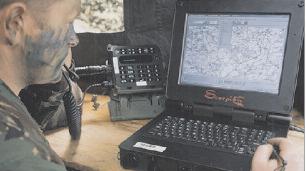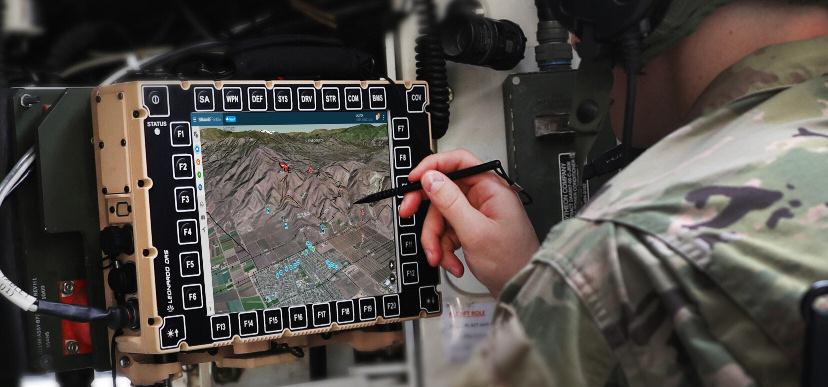
8 minute read
Leonardo DRS - Drawing Lessons from Years of Experience
ears Years osons Freswing LaDr om Y o To f Experiencs o e T olution Of Lavhe ESupport T emstsyactical S Tactical Snd T
Peter Hurst, Vice President, International Projects & Business Strategy at Leonardo DRS, Land Electronics For nearly 20 years, Leonardo DRS (DRS) has been involved in delivering cutting edge Ta actical Computing and Networking solutions t t d th l b Thi i h o cus omers around the globe. This rich heritage can be traced back to the inception of the UK Bowman project where DRS competed for and won a substantial contract for the vehicle-based tactical workstations in 2002. Key to the success of the programme was the high degree of commonality between the three di erent workstation variants: ta TVUDT (Vehicle User Da Terminal), BMD erminal), BMDT ta T(Bowman Management Da Terminal), and erminal), and PBPU (PBISA Processing Unit), leading to economies of scale and making software and through-life support economic and e ective. This initial modular and upgradeable approach proved to have long-term benefits to not only Leonardo DRS, but also to the U.K. Ministry of Defence (MoD).
Leonardo DRS provided more than 14,000 tactical user data terminals to General Dynamics UK (GD UK) for the initial Bowman ta Timplementation. The User Da e erminals (UDTs) are installed in all tactical vehicles, wheeled, and tracked, with the BMDT and VUDT (now referred to as CT1 and CT2) being dismountable for use within command posts or autonomously o the vehicle platform.
Leveraging Leonardo DRS’ position as the major supplier of tactical computing to the U.S. Army has been a core strategy of ours over several years. When we had the opportunity to re-compete for the Bowman UDTs in 2008, we took the approach that upgrading the delivered systems was the most competitive and impactful way to


BOWMAN in the field, 2002
providde the enhanced capability that the British h Army required.
Key to o this strategy was the high degree of re-uuse that could be made of vehicle infrast tructure, including cabling and installation kits, which represented a significant savings to the customer. In winninng the re-compete BCIP5.4/5.5 Bowman contra act in 2008, we were able to draw togethher the product development roadmaps for booth the US and UK Armies. We did so by leveraging technology drawn from the US Army Force XXI Battle Command Brigade and Below (FBCB2) contract that Leonardo DRS h had won and delivered to the U.S. Army at the time.
U.S. AND U.K. ALIGNMENT
In 2016, we were once again presented with an opportunity to compete for the next spiral of Bowman technology insertion in the form of Bowman 5.6. This was a key phase of development as 5.6 would provide the tactical computing infrastructure for a more open system as part of the evolution to the U.K. Morpheus program.
Maintaining our incumbent position on Bowman was, and is, of great importance to Leonardo DRS and the Bowman 5.6 project provided another opportunity to deliver a value-for-money solution (built on the principles discussed above). Leonardo DRS was pleased to be awarded the 5.6 contract continuing the highly successful partnership developed with both GD UK and the British Army.
On this occasion, we were able to exploit the U.S. Army Mounted Family of Computer Systems (MFoCS) contract that we had originally won in 2013, and again in 2018, in the form of MFoCS II. The U.S. Army MFoCS e ectively replaced FBCB2 so this was a natural progression and once more allowed Leonardo DRS to align the primary U.S. and U.K. brigade and below C4I projects by providing a solution, which had a high degree of commonality across both programmes.
It also ensured that Leonardo DRS continued to deliver the benefits of ongoing technology insertion underlying capability development insertion, underlying capability de and enhancement to both projects based on a significant degree of commonality in terms of the core computing, display, networking, and security architecture.
NO COMPROMISE
Leonardo DRS’ ultra-rugged tactical computers are designed to allow for ongoing technology insertion and upgrade. Over the course of a project the size of Bowman and MFoCS, we were able to use the same basic infrastructure to deliver ever-increasing amounts of capability as computing technology advanced. The Intel™ Core 2 Duo systems delivered back in 2002 have now been upgraded through two spirals to new Intel multi-core technology, maintaining legacy I/O and introducing new interfaces for future expansion. The ability to use the current infrastructure and upgrade the current systems is more cost-e ective than buying lower-grade, rugged COTS systems and ensures that there is no compromise regarding the environmental performance of the system. Modern Battle Management Systems (BMS) are mission-critical, and Leonardo DRS believes that there should be no compromise in their ability to perform in the harshest of conditions.
T Toda oday, Leonardo DRS’s tactical computing & networking products is the choice of wide range of demanding end-users ranging around the world.
Our systems are installed and operational in over 300,000 ground vehicles and command posts to-date and are delivering unparalleled performance in terms of reliability, availability, and resilience. In addition to the U.S. and U.K. installed bases, end-users in the Middle East t, Europe, South East Asia, Australia, and T Taiw aiwan have all adopted a wide range of DRS products to build their tactical C4/5i systems and solutions.
e of Land TAs the natur Tactical C4 actical C4/5i architectures change so our hardware and software continue to evolve to meet new and emerging requirements. T To c o continue, Leonardo DRS is also driving innovation and enhancing capabilities in the areas of Assured Position, Navigation and Timing (APNT) and Cybersecurity.
EMERGING CAPABILITIES
el partnerAs a major Int r, L , Leonardo DRS is participating in Intel’s Early Access Programme (EAP) for the 11th Generation Core Processing technology and is currently engaged in the development of computer mainboard’s that provide a step function enhancement in both CPU and GPU performance. This leap in CPU (x4 improvement in core CPU Passmark benchmark) and graphics (x8) performance is essential to supporting fast emerging BMS, Enhanced Situational Awareness (ESA), and related graphics intensive tactical applications. New higher speed GbE interfaces are also being introduced which are better suited to handling high bandwidth video interfaces such as those found on 00-82 compatible cameras and video feeds. These significant CPU, GPU, and I/O enhancements are at the heart of Leonardo DRS’s next generation tactical ti l tfcomputing pla orms.
These new enhanced computing continue to be married with the L DRS suite of agnostic networking communications, and platform m software such as the Voice Crossremote radio management and as voice comms capabilities of our d intercom system (VIS). platforms Leonardo g, anagement -banding, ssociated digital vehicle Leonardo DRS AC2ES Embedded APNT The Leonardo DRS modular and scalable APNT Converged Computer – Embedded & Scalable (AC2ES) solution can be readily ed within widely used DRS Tintegrat Tactical actical Systems such as the Data Distribution Unit (DDU) and o ers users with the ability to continue operations in GPS degraded environments.
AC2ES provides APNT capability by augmenting standard military GPS PNT source with technologies such as anti-jam, anti-spoof, M-code receivers, vehicle IR sensor vision navigation, wheel rotation, and inertial measurement units. A fusion engine merges and prioritizes all PNT sensor data to provide a reliable, GPS-denied navigation solution during real world jamming and spoofing attacks. AC2ES can operate standalone, or while hosting the vehicle’s BMS and can be easily controlled via its GUI.
Cybersecurity Leonardo DRS has been at thhe forefront of building and delivering cyber secure tactical systems since 2007. In addition t ion to attacks targeting operating system v vulnerabilities, modern threats are aggressiv vely targeting BIOS and firmware subsystemms within the computers themselves. Successful exploits at this level are extremely di c cult to detect and nearly impossible to remove. . Establishment of a Hardware Root of Trust (HRoT) and implementation of Transitive e Trust Chains
are key techno these threats. embedment a Platform Modu tactical compu has continued of this technol industry leade In 2011, Leonar a dedicated se containing the the associated (HSM). This Se system has be verifying integ risks, and prov in a high volum These technolo establishing a the basis for m of the comput
ologies for protecting against 7 In 2007, L , Leonardo DRS began nd provisioning of Trusted ules (TPMs) in fleet-base uters. Since then, Leonardo DRS to develop and expand its use logy and is now considered an er in embedded cybersecurity. rdo DRS began development of ecure TPM Provisioning Room e TPM Provisioning Server and d Hardware Security Module erver – Client provisioning ecome the cornerstone for grity, mitigating supply chain visioning of tactical computers me-manufacturing environment. ogies are critical for HRoT that can then be used as making integrity measurements ter’s subsystems.
Leonardo DRS S is in a unique position. We have derived a a great deal of experience in delivering tacttical systems content into the two largest BMS/C4I projects conceived in the form of FBCB2 evolving to MFoCS in the US and Bowman evolving to Morpheus in the UK. We have built on this position by working closely with many other international customers such as the Australian ADF and UAE GHQ.
This experience has provided us with a wealth of knowledge and capability that goes into everything we do. The development of new tactical computing platforms based on next generation 11 Intel technology, network agnostic software services coupled with innovative technologies such as AC2ES and robust cybersecure solutions continues to make Leonardo DRS the natural partner for today’s tactical system implementations.
7Visit Leonardo DRS at DSEi in Hall 7, booth , booth number 410 or at LeonardoDRS.com/ platform-computing.











